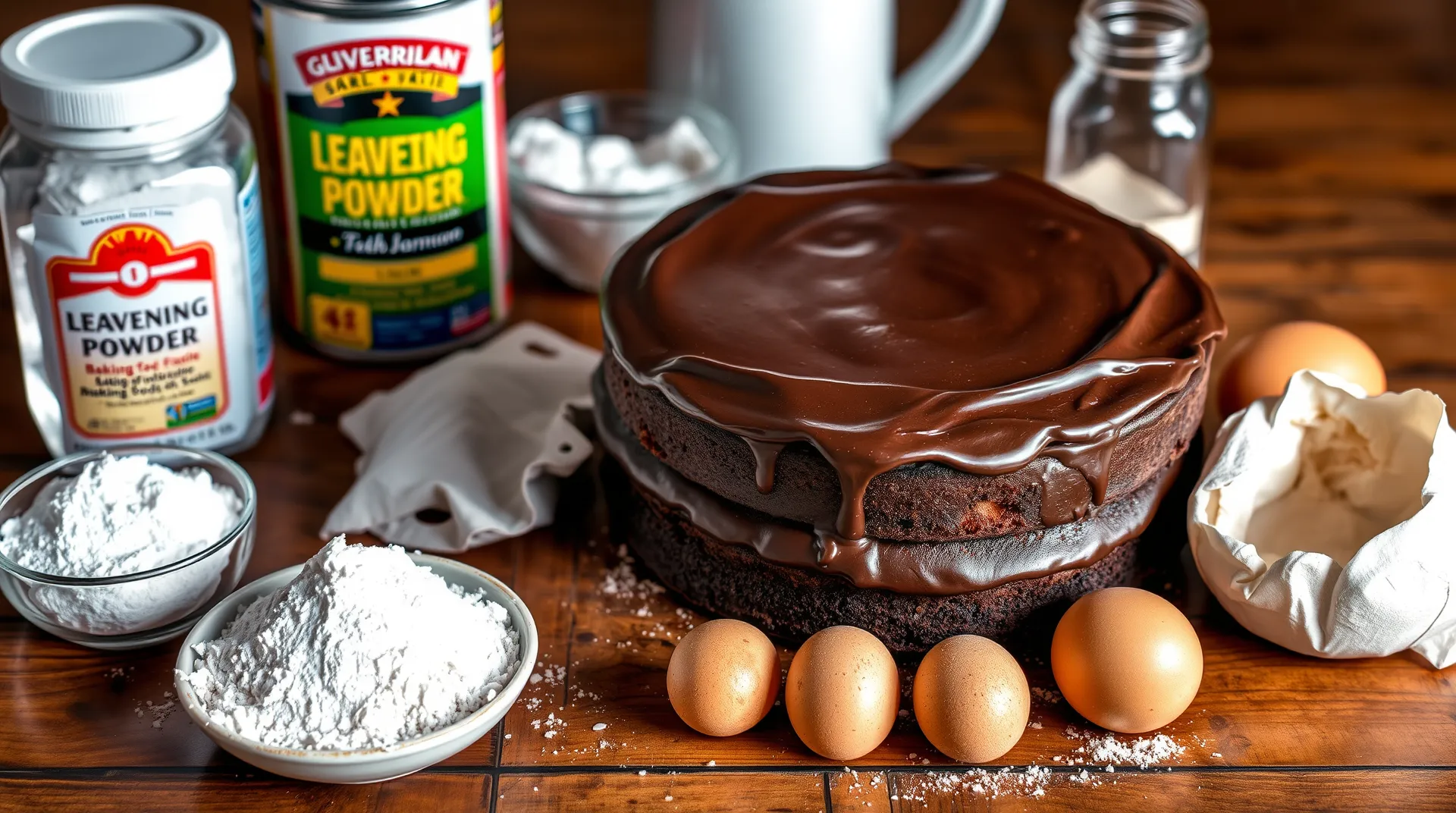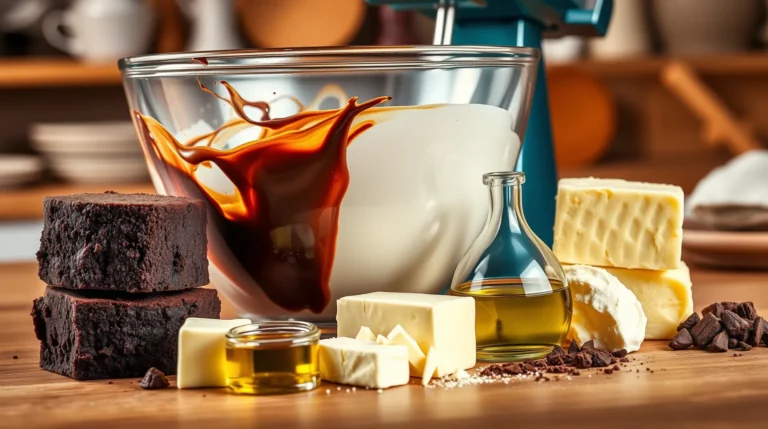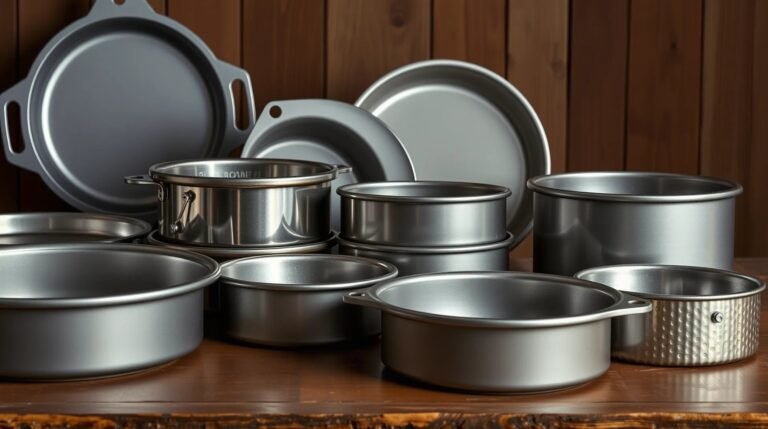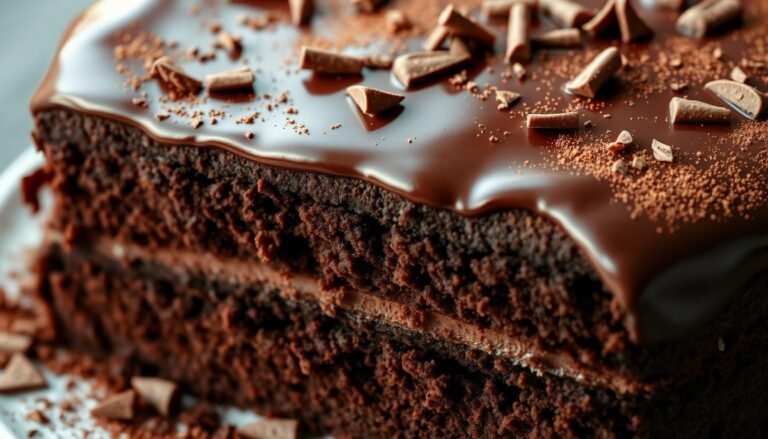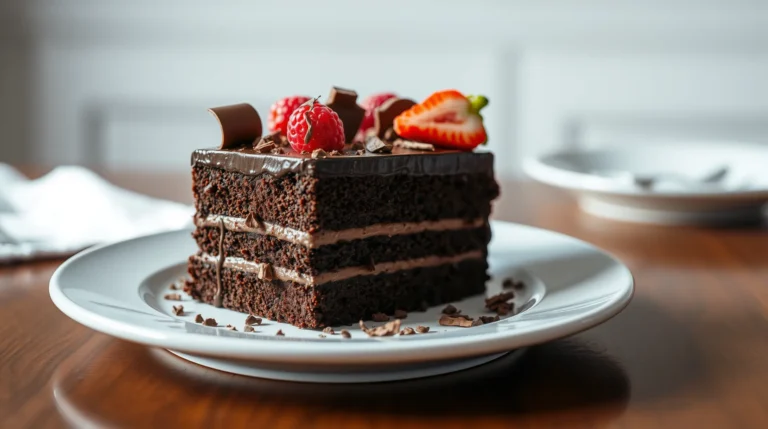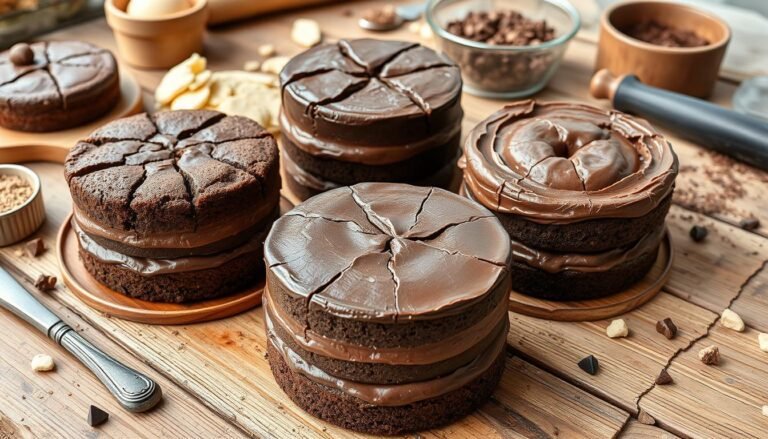Ultimate Baker’s Guide to Best Leavening Agents for Chocolate Cake
Ever bitten into a chocolate cake that’s as dense as a brick? It’s a disappointing experience. The problem is often the wrong or missing leavening agents. Without them, your cake won’t rise, leaving it flat and heavy.
But don’t worry! I’ve got the solution to elevate your chocolate cake game in 2024. Understanding baking chemistry is key to a perfect rise and texture. From baking soda to eggs, each ingredient is vital for a great cake.
Key Takeaways
- Leavening agents are key for light, airy chocolate cakes
- Chemical leaveners include baking soda and baking powder
- Room temperature ingredients help with better cake texture
- Proper mixing techniques prevent overmixing and ensure optimal rise
- Correct oven temperature is essential for perfect cake leavening
What Are Leavening Agents and Why Do We Need Them
Leavening agents are the heroes of baking. They are key for the perfect cake. They make cakes light and fluffy by creating air bubbles.
Definition and Role in Baking
Leavening agents make dough or batter rise by producing gas. They are vital for the right texture in baked goods. They create air pockets that make the crumb tender.
Importance for Cake Texture and Rise
Leavening agents do more than just make cakes rise. They are essential for the perfect feel and structure. Without them, cakes would be dense.
I’ve seen how leavening can turn a simple batter into a light, airy treat.
Types of Leavening Methods
There are three main leavening methods: chemical, biological, and natural. Each has its own uses in baking. Let’s look at how they compare:
| Leavening Type | Examples | Best For | Reaction Speed |
|---|---|---|---|
| Chemical | Baking soda, Baking powder | Cakes, Quick breads | Fast |
| Biological | Yeast | Bread, Pizza dough | Slow |
| Natural | Steam, Eggs | Soufflés, Meringues | Variable |
Understanding leavening agent reactions helps me make perfectly risen cakes. It’s amazing how these small ingredients can change our baking!
Types of Leavening Agents for Chocolate Cake
Chemical leaveners are key to baking a great chocolate cake. Knowing about baking soda and baking powder can really help. Let’s explore how they work.
Chemical Leaveners
Chemical leaveners make quick breads and cakes light and fluffy. They release carbon dioxide gas. This is thanks to baking soda and baking powder.
Baking Soda Properties and Usage
Baking soda is a game-changer in chocolate cake. It’s alkaline and needs acid to work. Buttermilk or cocoa powder add the acid needed.
The reaction happens fast. So, it’s important to bake the cake right after mixing.
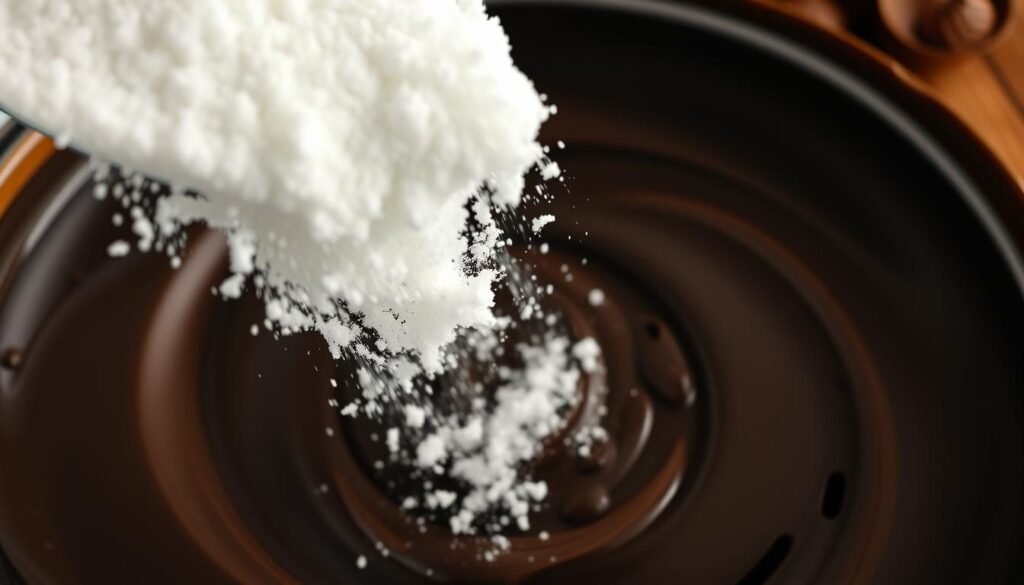
Baking Powder: Single-acting vs Double-acting
Baking powder comes in single-acting and double-acting types. Single-acting reacts with liquid only. Double-acting reacts twice, once mixed and again when heated.
This makes double-acting baking powder more common. It gives bakers more flexibility and ensures a good rise.
Chemistry of Baking Soda and Baking Powder in Chocolate Cake
The science behind leaveners is interesting. Baking soda not only leavens but also changes the cake’s color and flavor. It can make the cake darker and taste more chocolatey.
Baking powder is a complete leavening system. It helps keep more antioxidants in the cake. Some recipes use both for the best rise and flavor.
| Leavener | Reaction Time | Best For |
|---|---|---|
| Baking Soda | Immediate | Quick breads, cookies |
| Single-acting Baking Powder | When mixed with liquid | Pancakes, waffles |
| Double-acting Baking Powder | When mixed and when heated | Cakes, muffins |
Biological Leaveners
In my journey exploring cake baking, I’ve discovered the fascinating world of biological leaveners. These natural agents bring a unique twist to traditional baking methods, making chocolate cakes special.
Yeast in Cake Baking
Yeast, a staple in bread making, can also work wonders in cake baking. This tiny organism feeds on sugars, producing carbon dioxide through fermentation. The result? A cake with a distinct flavor profile and texture. Using yeast in chocolate cakes adds depth and complexity to the taste.
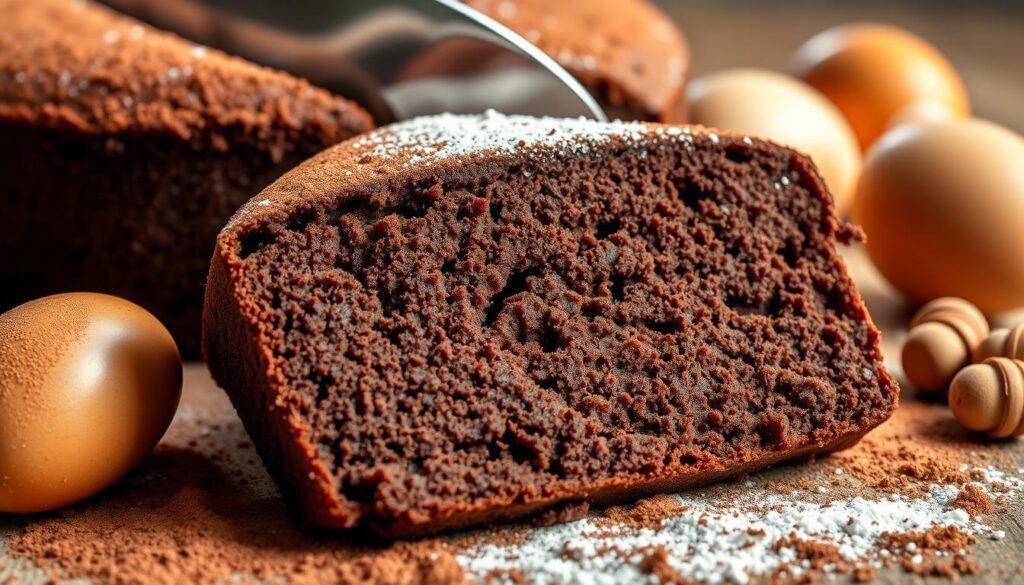
Sourdough Chocolate Cake
One of my favorite experiments has been creating a sourdough chocolate cake. By using a sourdough starter, I introduce natural yeasts and beneficial bacteria into the batter. This not only helps in leavening but also enhances the cake’s nutritional value through fermentation. The slight tang from the sourdough perfectly complements the rich chocolate flavor.
Fermentation and cake leavening go hand in hand when using biological agents. The process takes longer than chemical leaveners, but the wait is worth it. The slow rise allows flavors to develop fully, resulting in a more complex taste profile. Plus, the texture is often more tender and moist.
| Leavener Type | Leavening Process | Flavor Impact |
|---|---|---|
| Yeast | Fermentation | Complex, slightly tangy |
| Sourdough Starter | Natural yeast fermentation | Tangy, depth of flavor |
Experimenting with biological leaveners has opened up a whole new world of possibilities in my chocolate cake baking. It’s a fun way to create unique, flavorful cakes that stand out from the crowd.
Natural Leaveners
Natural leaveners are key in baking, like in chocolate cakes. Eggs are great for this. Whipping eggs adds air, making the cake light and fluffy.
Eggs: Whipping and Folding Techniques
Using eggs, I focus on whipping and folding right. Whipping egg whites can make them 8 times bigger! This air makes cakes rise well. Folding them into the batter keeps the air in.

Steam Leavening
Steam is another natural leavener I use. It’s good for wet recipes. As the batter heats, it turns to steam, making the cake rise. This works well with cocoa, which has lots of protein.
Vegan Alternatives
For vegan options, I’ve tried a few things. Aquafaba, from canned chickpeas, can act like egg whites. Mixing vinegar and baking soda also works, like traditional leaveners. These alternatives make cakes just as light as egg-based ones.
Learning these leavening methods has helped me make great chocolate cakes. Whether using eggs, steam, or vegan options, knowing how they work is key.
The Science of Chemical Leaveners in Chocolate Cake
I love baking chocolate cakes. Learning about leavening agents has made me better. Let’s explore how these ingredients make cakes rise and feel right.
Baking Soda and Cocoa Powder: A Dynamic Duo
The mix of cocoa powder and leavening is amazing. Baking soda, being alkaline, mixes with acidic cake ingredients. This mix creates carbon dioxide bubbles, which is key for a great rise.
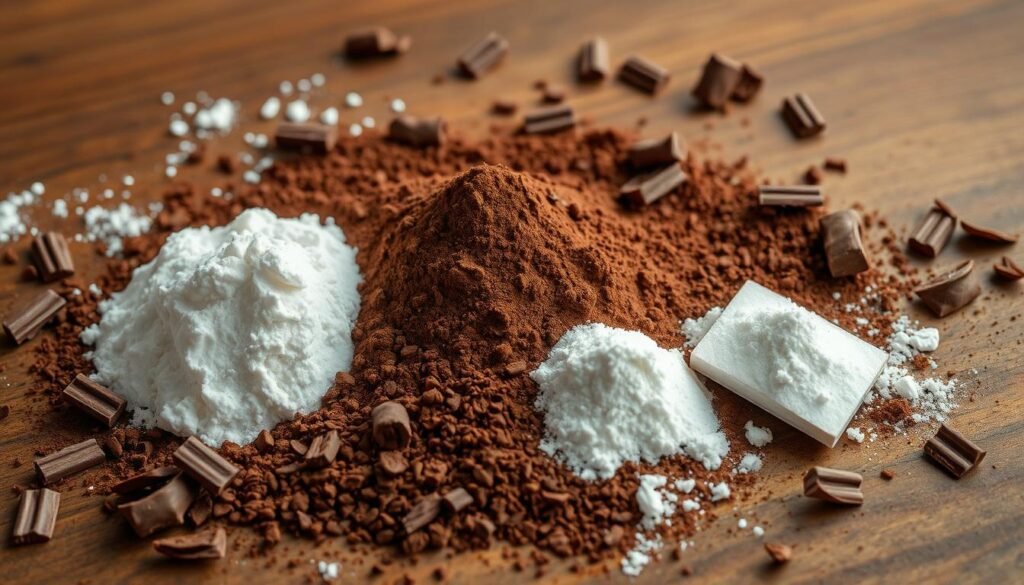
Balancing pH for Flavor and Rise
Getting pH levels right is important for both flavor and rise. Acidic ingredients like buttermilk or vinegar are essential. They start the leavening process by reacting with baking soda.
Baking Soda vs Baking Powder
Baking soda and baking powder have their uses. I choose baking powder for a controlled rise. It works twice: once with liquid and again when heated.
Keeping Leaveners Fresh
Keeping leaveners fresh is key for good baking. I keep baking powder in a cool, dry spot and check it often. A simple test: mix a teaspoon with warm water. If it fizzes, it’s good to use!
| Leavening Agent | Shelf Life | Testing Method |
|---|---|---|
| Baking Soda | 18-24 months | Mix with vinegar (should fizz) |
| Baking Powder | 18-24 months | Mix with warm water (should fizz) |
| Cream of Tartar | Indefinite if stored properly | Visual inspection for clumps |
Knowing these science basics has changed my chocolate cake baking. It’s not just about following a recipe. It’s about understanding the science behind each ingredient and how they work together to make that perfect slice of heaven.
Eggs as Natural Leavening Agents
Eggs are key in making cakes light and fluffy. They help cakes rise and give them a nice texture. Let’s see how eggs make chocolate cake special.
Role in Cake Structure and Leavening
Eggs do many things in baking. They add structure, moisture, and help cakes rise. The proteins in eggs, mainly in the whites, make cakes strong and light.
Egg yolks make baked goods rich and brown. This is thanks to the Maillard reaction.
Techniques for Incorporating Air
Whipping eggs is important for making cakes light. Beating egg whites creates air bubbles. This makes the cake fluffy.
But, don’t overbeat. Overbeating can ruin the texture.
How Eggs Complement Chemical Leaveners
Eggs and chemical leaveners like baking powder work together. Chemicals make gas, and eggs help hold it in. This makes cakes rise well and feel tender.
Vegan Egg Substitutes for Leavening
For vegans, there are egg substitutes that work well:
| Substitute | Amount | Best Used In |
|---|---|---|
| Applesauce | 50g per egg | Quick breads, muffins |
| Aquafaba | 3 tbsp per egg | Meringues, royal icing |
| Flax egg | 1 tbsp ground flax + 3 tbsp water | Cookies, brownies |
| Mashed banana | 1/4 cup per egg | Cakes, quick breads |
These substitutes can replace eggs in baking. They help make vegan treats just as tasty.
Mastering Leavening in Chocolate Cake Recipes
I’m excited to share my tips for perfecting chocolate cake leavening. Let’s dive into the secrets of achieving that perfect rise and texture!
Proper Measuring Techniques
Proper measuring of leaveners is key. I always use level measurements for baking soda and powder. Too much can make the cake taste bitter and not rise evenly.
Importance of Mixing Methods
Mixing methods for leavening are important for texture. I cream butter and sugar to add air. Then, I gently fold in dry ingredients to keep that air in.
Adjusting for Different Altitudes
High-altitude baking needs special adjustments. I reduce leaveners slightly and add more liquid at higher elevations. This helps with faster rising and drying.
Troubleshooting Common Leavening Issues
When troubleshooting cake rise, I first check the leaveners’ freshness. Old baking powder can make cakes flat. Too much leavener can cause sinking, while too little makes cakes dense.
Achieving the Perfect Crumb, Moisture, and Density
For moist chocolate cake tips, I balance leaveners with liquid. Using oil instead of butter often makes the cake moister. Here’s a breakdown of my favorite recipe ratios:
| Ingredient | Ratio | Purpose |
|---|---|---|
| Flour | 1 ⅔ cups | Structure |
| Cocoa Powder | ½ cup | Flavor |
| Baking Soda | ½ tbsp | Leavening |
| Coffee | ½ cup | Moisture and flavor enhancer |
| Oil | ¼ cup | Moistness |
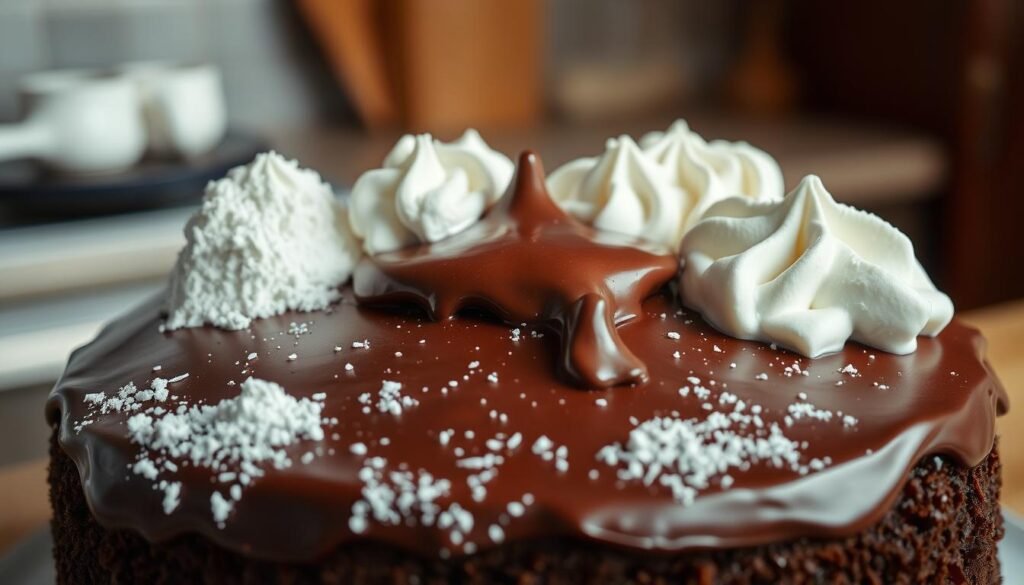
Remember, practice makes perfect. Don’t be afraid to experiment with these ratios to find your ideal chocolate cake texture!
Vegan and Alternative Leavening Options
Vegan leavening alternatives have changed plant-based baking. They let us make tasty, fluffy cakes without animal products. Let’s look at some popular plant-based leavening substitutes and how to mix them in recipes.
Plant-Based Leavening Substitutes
Vegan bakers have many leavening agent substitutes. Here are some good ones:
- Vinegar + Baking Soda: 1 tbsp vinegar with 1 tsp baking soda replaces one egg
- Aquafaba: 3 tbsp of this chickpea liquid substitutes one egg
- Mashed Banana: 1 ripe banana per egg adds moisture and softness
- Chia or Flax Seeds: 1 tbsp ground seeds with 3 tbsp water works well
Balancing Ingredients for Proper Rise
It’s key to balance leaveners in recipes for the right texture in vegan cakes. Mixing chemical leaveners with natural ingredients often works best. For example, using baking powder with applesauce gives both lift and moisture.
When using plant-based milk to activate baking soda, I pick something slightly acidic, like almond milk. This helps the leavening effect. Vegan baking is about being creative and precise in balancing ingredients for a great rise and texture in your chocolate cake.
Innovative Leavening Techniques for Chocolate Cake
I love trying new ways to make chocolate cake rise and taste great. Let’s look at some new leavening techniques that can improve your baking.
Combining Leavening Agents for Optimal Results
Mixing different leaveners can find the perfect balance. I’ve found that using yeast with baking powder speeds up rising when time is tight. This works best when yeast is at 100°F to 110°F.
Non-Traditional Leaveners
Trying non-traditional leaveners can lead to unique results. I’ve used carbonated water and even beer in my recipes. These add tiny bubbles for a light texture and rise.
Flavor Enhancement through Leavening
Leavening agents do more than just make cakes rise. They can also improve flavor. I like using buttermilk or sour cream with baking soda. They add a tangy flavor and help with rising.
| Leavening Agent | Function | Flavor Profile |
|---|---|---|
| Baking Powder | Rapid CO2 production | Neutral |
| Yeast | Slow, natural rise | Slightly fermented |
| Buttermilk + Baking Soda | Chemical reaction | Tangy |
| Carbonated Water | Introduces air bubbles | Neutral, light |
Remember, the right cake leavening ratios are key. Too much baking powder can make the cake bitter. Too little won’t rise enough. Finding the perfect balance is what makes a chocolate cake heavenly.
Comparing Leavening Methods for Chocolate Cake
I’ve tried many ways to make chocolate cakes rise. I found some interesting things about how they turn out.
Effectiveness of Different Leaveners
Baking powder makes cakes rise fast and reliably. Yeast adds special flavors. Whipped eggs help with texture. Each one changes the cake’s feel and taste.
Impact on Cake Texture and Flavor
Cakes with baking powder are lighter. Yeast makes them taste more complex. The choice of leavening changes how the cake feels and tastes. For instance, baking powder makes the crumb finer than yeast.
Best Practices for Each Method
For baking powder, measure right and mix well. With yeast, wait for it to ferment. For eggs, whip them right. These tips help your chocolate cakes rise and feel great.
| Leavening Method | Texture | Flavor Impact | Rise Speed |
|---|---|---|---|
| Baking Powder | Light, Fine Crumb | Neutral | Fast |
| Yeast | Denser, Chewier | Complex, Fermented | Slow |
| Whipped Eggs | Airy, Delicate | Subtle Richness | Medium |
Knowing these differences helps pick the best leavening method for your chocolate cake.
Advanced Leavening Concepts
I’ve learned that mastering leavening is key to creating the perfect chocolate cake. Let’s dive into some advanced concepts that can take your baking to the next level.
The Role of Temperature in Leavening Reactions
Temperature effects on leavening are very important. Baking at 350°F (180°C) gives me the best results. The heat makes the leavening agents work, creating gas and making the cake rise.
For a 9″ x 13″ pan, I bake for about 34 minutes. This ensures the cake reaches an internal temperature of 200°F to 210°F.
Interaction Between Leaveners and Other Ingredients
Leavening agent reactions are fascinating. The type of cocoa powder used greatly affects the cake’s texture. For example, Guittard Organic Natural cocoa powder makes a rich, full-bodied cake.
Hershey’s Natural cocoa powder, on the other hand, makes a lighter cake. This shows how different cocoa powders can change the cake’s texture.
Fine-tuning Leavening for Specific Chocolate Cake Styles
Fine-tuning leavening is key for different cake styles. I adjust the leavening agents to get the desired texture. For a denser, fudgier cake, I use less leavening.
For a lighter, airier cake, I add more leavening. This lets me create cakes that match different preferences.
| Cake Style | Leavening Adjustment | Cocoa Powder Type |
|---|---|---|
| Dense Fudgy | Reduce leavening by 25% | Guittard Organic Natural (22-24% fat) |
| Light and Airy | Increase leavening by 15% | Hershey’s Natural (10-13% fat) |
| Balanced Texture | Standard leavening | Callebaut Royal Dutch-Processed (22-24% fat) |
By understanding these advanced leavening concepts, I can create chocolate cakes that are tailored to specific preferences and styles. It’s all about balancing the ingredients and adjusting the leavening to achieve that perfect chocolate cake every time.
Leavening and Chocolate Types
I’ve found that the type of cocoa powder in chocolate cake recipes matters a lot. It’s all about how dutch-process cocoa and leavening agents work together. Let me explain it to you.
The pH Factor
The cake batter’s pH and leavening process are key. Dutch-process cocoa is less acidic than natural cocoa. This changes how it works with leavening agents. When I use dutch-process cocoa, I need to adjust my leavening strategy for the perfect rise.
Natural Cocoa’s Leavening Magic
Natural cocoa, on the other hand, is acidic. This acidity works great with baking soda. Recipes using natural cocoa and baking soda, like those in the 1961 Amy Vanderbilt’s Complete Cookbook, make cakes rise higher. They also have a reddish color. It’s all about the non-dutch cocoa leavening properties!
Choosing the Right Cocoa
When baking, I think about the leavening agents in my recipe. For cakes with baking soda and acidic ingredients, both natural and Dutch-process cocoas are good. But for a specific color or flavor, I might choose Hershey’s Special Dark or King Arthur’s Black Cocoa. It’s a mix of science and taste!


